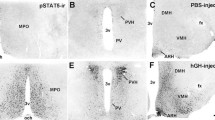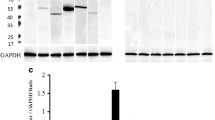Abstract
1.The rat olfactory system contains numerous target sites for 1,25-dihydroxyvitamin D3, as determined by receptor protein (VDR) immunocytochemistry and in situ hybidization.
2.Nuclear and cytoplasmic VDR immunoreactivity as well as the corresponding hybridization signal was observed in neurons in the olfactory epithelium, the olfactory bulb, and throughout the limbic system in locations also known to be glucocorticoid targets.
3.The widespread distribution of VDR indicates the distinct functional importance of 1,25-dihydroxyvitamin D3 for olfactory perception.
Similar content being viewed by others
REFERENCES
Alheid, G. F., de Olmos, J. S., and Beltramino, C. A. (1995). Amygdala and extended amygdala. In Paxinos, G. (ed.), The Rat Nervous System, Academic Press, Sydney, pp. 515–523.
Ayer-Lelievre, C., Olson, L., Ebendal, T., Seiger, A., and Person, H. (1988). Expression of the nerve growth factor gene in hippocampal neurons. Science 240:1339–1341.
Baker, A. R., McDonnell, D. P., Hughes, M., Crisp, T. M., Mangelsdorf, D. J., Haussler, M. R., Pike, J. W., Shine, J., and O'Malley, B. W. (1988). Cloning and expression of full-length cDNA encoding human vitamin D receptor. Proc. Natl. Acad. Sci. USA 85:3294–3298.
Beato, M., Herrlich, P., and Schütz, G. (1995). Steroid hormone receptors: many actors in search of a plot. Cell 83:851–857.
Breedlove, S. M. (1994). Sexual differentiation of the human nervous system. Annu. Rev. Psychol. 45:389–418.
Dulac, C. (1997). How does the brain smell? Neuron 19:447–480.
Fabre-Nys, C., Ohkura, S., and Kendrick, K. M. (1997). Male faces and odours evoke differential patterns of neurochemical release in the mediobasal hypothalamus of the ewe during oestrus: an insight into sexual motivation? Eur. J. Neurosci. 9:1666–1677.
Farach-Carson, M., and Devoll, R. (1995). Controlling the nongenomic actions of 1,25(OH)2D3, NIPS 10:198–203.
Friedrich, R. W., and Korsching, S. I. (1997). Combinatorial and chemotopic odorant coding in the zebrafish olfactory bulb visualized by optical imaging. Neuron 18:737–752.
Fuxe, K., Cintra, A., Agnati, L., Härfstrand, A., Wikstrom, A.-C., Okret, S., Zoli, M., Miller, L., Greene, L., and Gustafsson, J.-Å. (1987). Studies on the cellular localization and distribution of glucocorticoid receptor and estrogen receptor immunoreactivity in the central nervous system of the rat and their relationship to the monoaminergic and peptidergic neurons of the brain. J. Steroid Biochem. 27:159–170.
Kumar, R., Schaefer, J. S., Grande, J. P., and Roche, P. C. (1994). Immuno-localization of the calcitriol receptor, 24-hydroxylase cytochrome P-450 and calbindin D28K in human kidney. Am. J. Physiol. 266: F477-F485.
Lehman, M. N., Ebling, F. J. P., Moenter, S. M., and Karsch, F. J. (1993). Distribution of estrogen receptor-immunoreactive cells in the sheep brain. Endocrinology 133:876–886.
Mirzahosseini, S., Karabélyos, Cs., Dobozy, O., and Csaba, G. (1996). Changes in sexual behaviour of adult male and female rats neonatally treated with vitamin D3. Hum. Exp. Toxicol. 15:573–576.
Morimoto, M., Morita, N., Ozawa, H., Yokoyama, K., and Kawata, M. (1996). Distribution of glucocorticoid receptor immunoreactivity and mRNA in the rat brain: An immunohistocytochemical and in situ hybridisation study. Neurosci. Res. 26:235–269.
Paxinos, G., and Watson, C. (1986). The Rat Brain in Stereotaxic Coordinates, Academic Press, San Diego.
Prüfer, K., and Jirikowski, G. F. (1997). Vitamin D receptor is partly colocalized with oxytocin immunoreactivity in neurons of the male rat hypothalamus. Cell. Mol. Biol. 43:543–548.
Prüfer, K., Platzer, C., and Jirikowski, G. F. (1997). Distribution of vitamin D receptor immunoreactive neurons in the rat hypothalamus. Eur. J. Anat. 1:145–150.
Prüfer, K., Veenstra, T. D., Jirikowski, G. F., and Kumar, R. (1999). Immunolocalization of the 1,25-dihydroxyvitamin D3 receptor in the central nervous system of the rat. J. Chem. Neuroanat. 76:735–745 (1999).
Puymirat, J., Miehe, M., Marchand, R., Sarlieve, L., and Dussault, J. H., (1991). Immunocytochemical localization of thyroid hormone receptors in the adult rat brain. Thyroid 1:173–184.
Segovia, S., and Guillamon, A. (1993). Sexual dimorphism in the vomeronasal pathway and sex differences in reproduction behaviour. Brain Res. Rev. 18:51–74.
Segovia, S., and Guillamon, A. (1996). Searching for sex differences in the vomeronasal pathway. Horm. Behav. 30:618–626.
Shipley, M. T., McLean, J. H. and Ennis, M. (1995). Olfactory system. In G. Paxinos (ed.),; The Rat Nervous System, Academic Press, Sydney, pp. 899–922.
Simerly, R. B. (1990). Hormonal control of neuropeptide gene expression in sexually dimorphic olfactory pathways. Trends Neurosci. 13:104–110.
Sonnenberg, J. (1986). 1,25-Dihydroxyvitamin D3 treatment results in increased choline acetyltransferase activity in specific brain nuclei. Endocrinology 118:1433–1439
Stumpf, W. E., and Denny, M. E. (1989). Vitamin D (soltriol), light, and reproduction. Am. J. Obstet. Gynecol. 161:1375–1384.
Stumpf, W. E., and O'Brian, L. P. (1987). 1,25(OH)2 vitamin D3 sites of action in the brain. Histochemistry 87:393–406.
Stumpf, W. E., and Privette, T. H. (1989). Light, vitamin D and psychiatry. Psychopharmacology 97:285–294.
Stumpf, W. E., and Sar, M. (1976). Steroid hormone target sites in the brain the differential distribution of estrogen, progestin, androgen and glucocorticosteroid. J. Biochem. 7:1163–1170.
Swann, J. M. (1997). Gonadal steroids regulate behavioral responses to pheromones by actions on a vision of medial preoptic area. Brain Res. 750:189–194.
Veenstra, T. D., Londowski, J. L., Birmijoin, S., Windebank, A. J., and Kumar, R. (1997). 1,25-Dihydroxyvitamin D3 induces differentiation of neuroblastoma cells by increasing the expression of nerve growth factor. Dev. Brain Res. 99:53–60.
Wion, D., MacGrogan, D., Neveu, I., Jehan, F., Houlgatte, R., and Brachet, P. (1991). 1,25-Dihydroxyvitamin D3 is a potent inducer of nerve growth factor synthesis. J. Neurosci. Res. 28:110–111.
Wood, R. I., and Coolen, L. M. (1997). Integration of chemosensory and hormonal cues is essential for sexual behaviour in the male syrian hamster: Role of the medial amygdaloid nucleus. Neuroscience 78:1027–1035.
Author information
Authors and Affiliations
Rights and permissions
About this article
Cite this article
Glaser, S.D., Veenstra, T.D., Jirikowski, G.F. et al. Distribution of 1,25-Dihydroxyvitamin D3 Receptor Immunoreactivity in the Rat Olfactory System. Cell Mol Neurobiol 19, 613–624 (1999). https://doi.org/10.1023/A:1006932418220
Issue Date:
DOI: https://doi.org/10.1023/A:1006932418220




